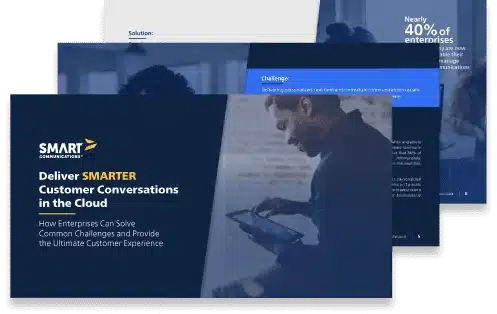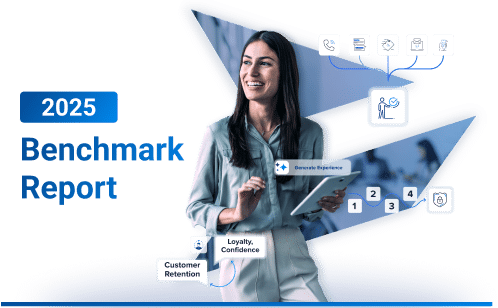Digital Transformation in Healthcare Claims
By: John Zimmerer, VP Healthcare Marketing at Smart Communications
Digital transformation in healthcare had been moving at a steady but very slow pace for years – until the pandemic forced the industry to accelerate its digital-first initiatives. Despite the progress made in the last 18 months, the healthcare industry still has plenty of opportunity to enhance the customer experience through more digital interactions.
One critical customer journey where this is particularly evident is claims. From finding, figuring out, filling out and submitting a claim form (e.g., for an out-of-network service); to receiving an adjudication notice, navigating to and reviewing an Explanation of Benefits (EOB); to having to contact the payer to ask a question about the claim and submitting an appeal, the whole process can often feel disjointed and inefficient.
In this post, we dive into the future of digital transformation in healthcare and how payers can reimagine the claims experience.
The Current State of the Claims Journey
Often, claims are considered a cost of doing business for health insurers. As a key component of the Medical Loss Ratio (MLR), an insurer’s primary objective is usually to minimize the administration and operational expenses related to processing claims and handling appeals and grievances.
Many claim-related communications are designed from the inside out, with regulations and risk in mind rather than with an eye toward the customer experience. Once the templates are created, they tend not to be revised much unless required by rule or due to an acquisition. These communications are treated as individual point solutions managed by IT, rather than as touchpoints that connect a customer journey.
Here’s a summary of today’s typical claim-related experience:
- The member, Grace, receives an email notifying her that “a claim was recently processed.” Grace wonders which claim the email is referencing.
- The email directs Grace to log into her payer’s member portal to review the claim. Grace looks for a link in the email to click but doesn’t see one. She opens a browser, logs in to her payer’s member portal, and navigates to claims.
- Grace deduces which claim the email was referring to. She didn’t see a visual indicator, like a “new” tag or other label, so she assumes she’s looking for the most recent claim.
- Grace clicks on the claim line item to view summary information, then on the EOB to see details. The EOB is a PDF file, originally designed to be printed and mailed, not for viewing on a computer screen or a mobile device.
- Grace has a question about the claim. The EOB directs her (and every other member) to call her plan’s member services department. Grace would have preferred a self-service option.
- Grace tells the member services rep that takes her call that she is certain that she had already satisfied her deductible prior to the date of service in question and feels that her responsible portion should be much lower. The call center rep points Grace to a form to request a redetermination (i.e., to file an appeal) and asks Grace if there’s anything else the rep can help Grace with.
- A bit frustrated that her issue hasn’t been resolved to her satisfaction, Grace says, “no,” and hangs up the phone. She starts looking for the form the rep mentioned and wonders how she’ll know the payer has received it or how long it will take before her payer begins the redetermination process.
This interaction just increased the risk that Grace will not renew her plan (i.e., churn), but her payer doesn’t know that yet.
The Desired Future State of the Claims Journey
Fortunately, there is a better way that is relatively simple to implement and will deliver immediate value. A new, orchestrated process can connect these disjointed touchpoints into a guided experience and increase member satisfaction (and NPS scores). This future state can also lower claims administration expenses, especially for individual and group plans where these costs tend to be highest.
Here’s a revised version of the scenario above:
- Grace sees a new link in the EOB to ask a question. The virtual agent senses the context of the question and pulls in information related to the specific claim.
- After answering a few questions, the agent prepares, and Grace reviews and submits, a request for an organizational redetermination (i.e., a Level 1 appeal). All the information required for the appeal is prepopulated which means Grace clicks more than she types.
- The request creates a case for the Appeals and Grievances (AG) group to review the claim. The case includes the appeal form with the information Grace provided.
- The AG employee reviews the case and creates a determination letter from within her CRM. In this case, the request is approved; however, the editing software is flexible and allows the AG employee to create different correspondence if the request is approved, denied or pending (e.g., if additional information is required).
- Upon generating the correspondence, Grace is sent an email with the determination letter attached and an NPS survey in the body of the email.
- The entire history of engagements and all related activity – sends, opens, clicks, etc. – is available to any payer employee authorized to access Grace’s CRM record.
This future-state scenario is achievable with The Conversation CloudTM from Smart Communications, including these solutions for connecting the claims experience:
- SmartCOMMTM for sending the notification, EOB and correspondence
- SmartIQTM for the internal appeal request, consent form and NPS survey
- Orchestration across all the touchpoints and channels
- Integrations, e.g., with Facets for claims data and Salesforce for case management
Accelerate Digital Transformation in Healthcare Claims
Smart Communications has helped accelerate digital transformation in healthcare claims for insurers like Blue Shield of California through its ISO-certified and HIPAA-compliant Conversation Cloud platform.
Ready to enable new members to self serve and streamline claims processes to improve member experience and reduce administration costs? Watch how our solutions help organiations like yours make connected claims experiences possible.



